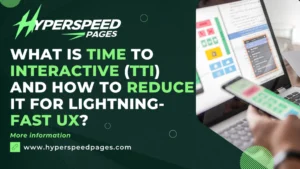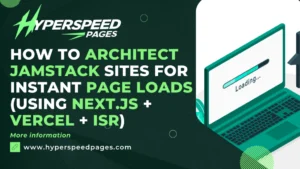![How to Design and Develop Sign-up Landing Pages? [2024 Edition]](https://hyperspeedpages.com/wp-content/uploads/2024/08/How-to-Design-and-Develop-Sign-up-Landing-Pages-2024-Edition.webp)
Creating an effective sign-up landing page is crucial for businesses looking to convert visitors into leads or customers. A well-designed landing page can significantly impact your conversion rates by providing a seamless user experience and encouraging users to take action. This comprehensive guide will walk you through the essential steps to design and develop high-converting sign-up landing pages.
Understanding the Purpose of a Sign-Up Landing Page
A sign-up landing page is a standalone web page designed to capture a visitor’s information through a form. The primary goal is to convert visitors into leads by encouraging them to provide their contact details in exchange for a valuable offer, such as a free trial, ebook, newsletter subscription, or webinar registration. A successful sign-up landing page must be focused, compelling, and easy to navigate.
Key Elements of a High-Converting Sign-Up Landing Page
1. Clear and Compelling Headline
The headline is the first thing visitors see when they arrive on your landing page. It should immediately convey the value of your offer and capture the visitor’s attention. A compelling headline is clear, concise, and aligned with the visitor’s intent. Use action-oriented language and emphasize the benefits of signing up.
Example: “Unlock Exclusive Insights: Subscribe Now for Free Weekly Market Reports”
2. Engaging Visuals
Visual elements, such as images, videos, and graphics, play a crucial role in capturing attention and conveying your message. Use high-quality visuals that are relevant to your offer and enhance the overall user experience. Videos can be particularly effective in explaining complex concepts or demonstrating product features.
Tip: Ensure that your visuals are optimized for fast loading times to prevent users from leaving your page due to slow performance.
3. Persuasive Copywriting
The copy on your landing page should be persuasive and focused on the benefits of your offer. Highlight the value proposition and address any potential objections or concerns visitors may have. Use concise and straightforward language, and include bullet points or short paragraphs for easy readability.
Example: “Join our newsletter to receive exclusive tips and strategies that will help you grow your business. No spam, just valuable insights delivered to your inbox every week.”
4. User-Friendly Form
The sign-up form is the most critical element of your landing page. It should be easy to fill out and require only essential information. Ask for the minimum number of fields necessary to achieve your goals. For instance, requesting just a name and email address often results in higher conversion rates compared to longer forms.
Tip: Use inline form validation to provide immediate feedback and reduce errors, enhancing the user experience.
5. Strong Call-to-Action (CTA)
Your call-to-action should be prominent, persuasive, and aligned with the visitor’s intent. Use action-oriented language and make it clear what users will gain by clicking the CTA button. The CTA button should stand out visually and be easy to find on the page.
Example: “Get Started Today” or “Download Your Free Guide Now”
6. Trust Indicators
Trust indicators, such as testimonials, reviews, trust badges, and privacy assurances, can help alleviate concerns and build credibility. Including testimonials from satisfied customers or showcasing the number of subscribers can instill confidence in potential sign-ups.
Tip: Highlight privacy policies and data protection measures to reassure visitors that their information is secure.
7. Mobile Optimization
With an increasing number of users accessing the internet via mobile devices, it’s essential to ensure your mobile app landing page is fully responsive and mobile-friendly. Test your page on various devices and screen sizes to ensure a seamless experience for all users.
Tip: Use a mobile-first design approach to prioritize the mobile user experience.
Landing Page Design Best Practices for 2024
1. Minimalist Design
Minimalist design continues to be a popular trend, focusing on simplicity and clarity. Use plenty of white space to create a clean and uncluttered look. Avoid distractions and keep the user’s focus on the core elements of the page.
2. Personalized Content
Personalization can significantly enhance the user experience by delivering relevant content based on user behavior and preferences. Use dynamic content to tailor your landing page to individual visitors, increasing the likelihood of conversion.
3. Interactive Elements
Incorporate interactive elements, such as quizzes, polls, or sliders, to engage visitors and make the experience more memorable. Interactive elements can encourage users to spend more time on your page and provide valuable insights into their preferences.
4. Dark Mode
Dark mode is becoming increasingly popular for its aesthetic appeal and reduced eye strain. Consider offering a dark mode option to cater to users who prefer this viewing experience.
Development Considerations
1. Fast Loading Times
Page speed is a critical factor in user experience and search engine rankings. Optimize images, leverage browser caching, and use a content delivery network (CDN) to ensure fast loading times.
2. A/B Testing
A/B testing is essential for optimizing your landing page’s performance. Test different headlines, visuals, copy, and CTAs to identify what resonates best with your audience. Use data-driven insights to make informed decisions and continually improve your page.
3. Analytics and Tracking
Implement analytics tools to track user behavior and conversion rates. Analyze the data to gain insights into user interactions and identify areas for improvement. Monitor key metrics, such as bounce rate, time on page, and form completion rates.
4. Accessibility
Ensure your landing page is accessible to all users, including those with disabilities. Follow the Web Content Accessibility Guidelines (WCAG) to make your page usable for everyone. Use descriptive alt text for images and ensure proper color contrast.
Types of Landing Pages
Landing pages serve various purposes, and their structure and content vary accordingly.
Here’s a breakdown of the most common types:
1. Lead Generation Landing Pages
Purpose:
Lead generation landing pages, also known as “lead capture pages,” aim to collect visitor information such as names, email addresses, and phone numbers. They are used to generate leads that can be nurtured through email marketing or sales follow-ups.
Features:
- Form Fields: These pages prominently feature forms to capture visitor information.
- Value Proposition: They offer something valuable in exchange for the visitor’s details, such as an ebook, webinar access, or a free consultation.
- Minimal Navigation: Limited navigation options help keep the visitor focused on the form.
Example Use Cases:
- Downloadable resources (e.g., whitepapers, reports)
- Event registrations
- Newsletter sign-ups
2. Click-Through Landing Pages
Purpose:
Click-through landing pages aim to persuade visitors to click a button that takes them to another page, usually to complete a purchase or sign-up process. These pages act as intermediaries between an ad and the final conversion step.
Features:
- Persuasive Content: They contain compelling information about a product or service to motivate the visitor to proceed.
- Clear Call-to-Action (CTA): The CTA button directs the user to the next step in the conversion funnel, such as a shopping cart or subscription page.
- Engaging Visuals: High-quality images or videos can be used to illustrate product benefits.
Example Use Cases:
- Pre-purchase product information
- Free trial promotions
- App downloads
Sales Landing Pages
Purpose:
Sales funnel landing pages are designed to convert visitors into paying customers by persuading them to make a purchase directly on the page.
Features:
- Detailed Product Information: Extensive details about the product or service, including features, benefits, pricing, and guarantees.
- Social Proof: Customer reviews, testimonials, and case studies to build trust and credibility.
- Prominent CTA: The page includes multiple strategically placed CTAs to guide the user toward the purchase.
Example Use Cases:
- Limited-time offers or discounts
- Product launches
- Direct sales of services or digital products
Squeeze Pages
Purpose:
Squeeze pages are a specific type of lead generation page focused on capturing email addresses. They are usually short, with a simple design to minimize distractions.
Features:
- Minimal Content: Very concise with limited text to encourage quick sign-up.
- Urgent CTA: Often includes urgency or scarcity elements to prompt immediate action (e.g., “Sign up now to receive your free guide!”).
- Simplified Design: Stripped-down layout with few, if any, navigation links.
Example Use Cases:
- Newsletter or email list subscriptions
- Early access or VIP offers
- Exclusive content delivery
5. Long-Form Landing Pages
Purpose:
Long-form landing pages are designed to provide detailed information about a product or service, catering to audiences who need more information before making a decision.
Features:
- In-Depth Content: Includes comprehensive explanations, stories, and evidence supporting the value of the product or service.
- Multiple Sections: The page may contain testimonials, detailed features, comparisons, FAQs, and more.
- Multiple CTAs: CTAs are scattered throughout to capture interest at different points in the user journey.
Example Use Cases:
High-ticket products or services
Complex products requiring detailed explanations
Educational or informational content
6. Thank You Pages
Purpose:
Thank you pages are shown after a visitor completes a desired action, such as signing up or making a purchase. They serve to confirm the action and provide additional information or next steps.
Features:
- Confirmation Message: Acknowledges the completion of the desired action and thanks the user.
- Additional CTAs: Offers further engagement opportunities, such as social media sharing or related content.
- Next Steps: Provides guidance on what the user can do next, such as checking their email for further instructions.
Example Use Cases:
- Post-purchase confirmation
- Subscription confirmation
- Download instructions for digital products
7. Coming Soon Landing Pages
Purpose:
Coming soon landing pages are used to generate excitement and gather interest for an upcoming product, service, or event.
Features:
- Teaser Content: Provides a sneak peek or teaser of what’s to come, building anticipation.
- Email Capture Form: Collects emails for notifications or early access.
- Countdown Timer: Displays a countdown to the launch date to create urgency.
Example Use Cases:
- Product launches
- New website or app launches
- Event announcements
Differences Between Landing Pages
Purpose and Goal:
- Lead Generation Pages focus on collecting visitor information.
- Click-Through Pages drive visitors to the next step in the conversion process.
- Sales Pages aim to close the sale directly on the page.
- Squeeze Pages are minimalist and focus on email capture.
- Long-Form Pages provide extensive information for informed decision-making.
- Thank You Pages confirm actions and guide users on next steps.
- Coming Soon Pages generate interest and anticipation.
Design and Content:
- Lead Generation Pages use forms and value propositions.
- Click-Through Pages rely on persuasive content and CTAs.
- Sales Pages emphasize product details and social proof.
- Squeeze Pages have minimal content and urgency.
- Long-Form Pages include comprehensive sections and multiple CTAs.
- Thank You Pages offer confirmation and additional engagement.
- Coming Soon Pages use teasers and countdowns.
User Experience:
- Lead Generation and Squeeze Pages prioritize simplicity for quick sign-ups.
- Click-Through and Sales Pages focus on persuasion to drive specific actions.
- Long-Form Pages cater to users seeking detailed information.
- Thank You Pages ensure users feel acknowledged and directed.
- Coming Soon Pages build excitement and capture interest
Landing Page Development Tools and Platforms
- Landing Page Builders: Unbounce, Leadpages, Instapage
- Content Management Systems (CMS): WordPress, Wix, Squarespace
- Email Marketing Platforms: Mailchimp, ConvertKit, HubSpot
- Design Tools: Adobe Photoshop, Figma, Sketch
Designing and developing a high-converting sign-up landing page is a multifaceted process that requires a deep understanding of your target audience, clear goals, and a focus on user experience.
Source:

![How to Design and Develop Sign-up Landing Pages? [2024 Edition]](https://hyperspeedpages.com/wp-content/uploads/2024/08/How-to-Design-and-Develop-Sign-up-Landing-Pages-2024-Edition-768x432.webp)


